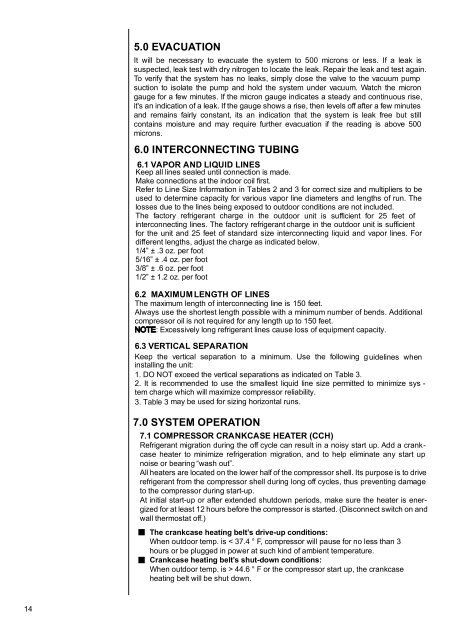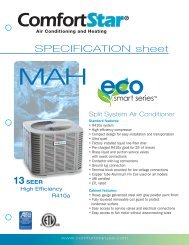Installation &Operation Instructions For R410A (MAH ... - ComfortStar
Installation &Operation Instructions For R410A (MAH ... - ComfortStar
Installation &Operation Instructions For R410A (MAH ... - ComfortStar
You also want an ePaper? Increase the reach of your titles
YUMPU automatically turns print PDFs into web optimized ePapers that Google loves.
14<br />
5.0 EVACUATION<br />
It will be necessary to evacuate the system to 500 microns or less. If a leak is<br />
suspected, leak test with dry nitrogen to locate the leak. Repair the leak and test again.<br />
To verify that the system has no leaks, simply close the valve to the vacuum pump<br />
suction to isolate the pump and hold the system under vacuum. Watch the micron<br />
gauge for a few minutes. If the micron gauge indicates a steady and continuous rise,<br />
it's an indication of a leak. If the gauge shows a rise, then levels off after a few minutes<br />
and remains fairly constant, its an indication that the system is leak free but still<br />
contains moisture and may require further evacuation if the reading is above 500<br />
microns.<br />
6 .0 INTERCONNECTING TUBING<br />
6 .1 VAPOR AND LIQUID LINES<br />
Keep all lines sealed until connection is made.<br />
Make connections at the indoor coil first.<br />
Refer to Li ne Size Information in Ta bles 2 and 3 for correct size and multipliers to be<br />
used to determine capacity for various vapor line diameters and lengths of run. The<br />
losses due to the lines being exposed to outdoor conditions are not included.<br />
The factory refrigerant charge in the o utdoor unit is s ufficient for 25 feet of<br />
interc onnecting lines. The factory refrigerant charge in the outdoor unit is sufficient<br />
for the unit and 25 feet of standard size interconnecting l iquid and vapor lines. <strong>For</strong><br />
diff erent lengths, adjust the charge as indicated below.<br />
1/4” ± .3 oz. per foot<br />
5/16” ± .4 oz. per foot<br />
3/8” ± .6 oz . per foot<br />
1/2” ± 1.2 oz . per foot<br />
6 .2 M AXIMUM LENGTH OF LINES<br />
T h e maximum length of interconnecting line is 150 feet.<br />
Always use the shortest length possible with a minimu m number of bends. Additional<br />
compressor oil is not required for any length up to 150 feet.<br />
NOTE: Excessively long refrigerant lines cause loss of equipment capacity.<br />
6 .3 V ERTICAL SEPARATION<br />
Keep the vertical separation to a minimum. Use the following g uidelines when<br />
installing the unit:<br />
1. DO NOT exceed the vertical separations as indicated on Table 3.<br />
2. It is recommended to use the smallest liquid line size permitted to minimize sys -<br />
t em charge which will maximize compressor reliability.<br />
3. Table 3 may be used for sizing horizontal runs.<br />
7.0 SYSTEM OPERATION<br />
7.1 COMPRESSOR CRANKCASE HEATER (CCH)<br />
Refrigerant migration during the off cycle can result in a noisy start up. Add a crankcase<br />
heater to minimize refrigeration migration, and to help eliminate any start up<br />
noise or bearing “wash out”.<br />
All heaters are located on the lower half of the compressor shell. Its purpose is to drive<br />
refrigerant from the compressor shell during long off cycles, thus preventing damage<br />
to the compressor during start-up.<br />
At initial start-up or after extended shutdown periods, make sure the heater is energized<br />
for at least 12 hours before the compressor is started. (Disconnect switch on and<br />
wall thermostat off.)<br />
The crankcase heating belt’s drive-up conditions:<br />
When outdoor temp. is < 37.4 ° F, compressor will pause for no less than 3<br />
hours or be plugged in power at such kind of ambient temperature.<br />
Crankcase heating belt’s shut-down conditions:<br />
When outdoor temp. is > 44.6 ° F or the compressor start up, the crankcase<br />
heating belt will be shut down.




